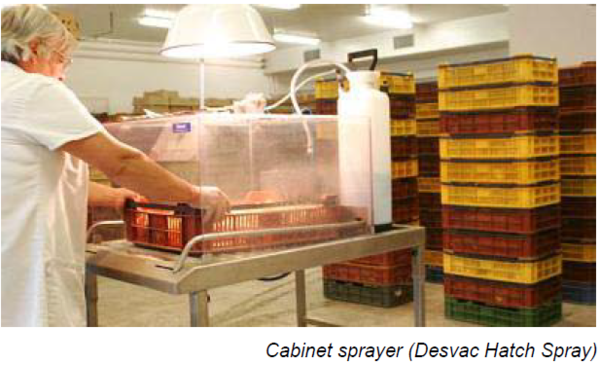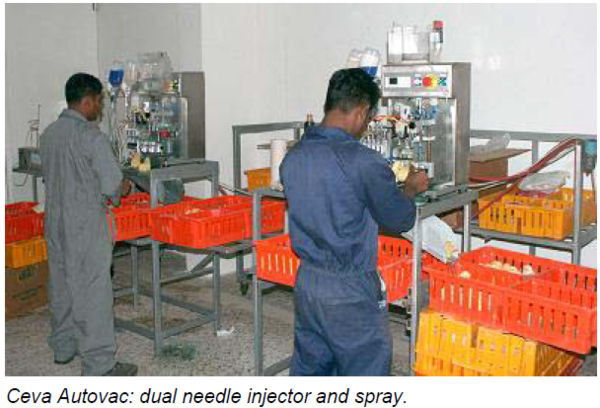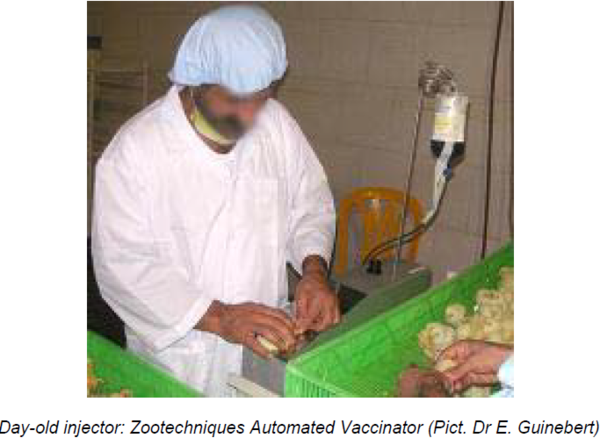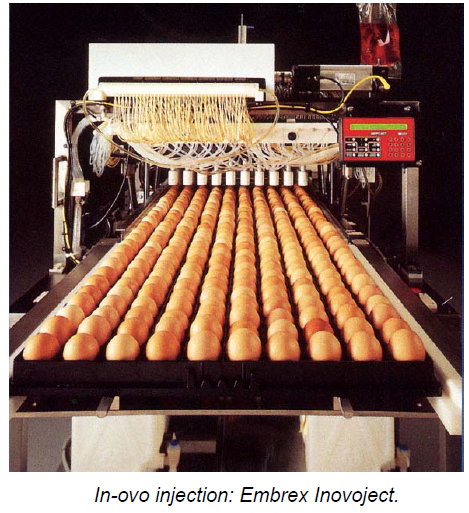...
--> Why perform hatchery vaccination?
- Epidemiological background
- Sanitary background
- Qualitative aspect
- Financial and human aspect, and public image
--> Vaccinations available at the hatchery
- Infectious Bursal Disease (Gumboro Disease)
- Newcastle Disease
- Infectious Bronchitis
- Marek’s Disease
- Coccidiosis
- Influenza
- Fowl Pox
--> Management of vaccine interactions
--> Conclusion
...
VACCINATION IN THE HATCHERIES
By Dr Stephan WARIN, DVM, International Product Manager - Avian Business Unit
CEVA Santé Animale, La Ballastiere, BP 126, 33501 Libourne Cedex, France
.
1. WHY PERFORM HATCHERY VACCINATION?
Why decide to perform vaccinations at the hachery when these can be carried out on the farm? Why still adding to the number of operations undergone by chicks (sexing, sorting, packing in boxes, etc.) and delaying delivery even more? Because there are multiple pros to it, which largely outweigh the cons.
1.1. Epidemiological Background
A high field infectious pressure will prompt to vaccinate the chick as soon as possible, i.e. upon hatching, or even before, in order to gain precious hours or days on wild viruses. As vaccine viruses usually multiply slowlier than their wild cousins, they will have more time to stimulate the young bird’s immunity, paticularly for vaccination against Marek’s disease (Sharma, 1982).
.
1.2. Sanitary Background
Sanitary controls and staff training and supervision obey to stricter requirements at the hatchery than on the farm. Ventilation, temperature and relative humidity are all controlled in a hatchery. Hygiene is better than on the farm: clean hands, wearing of a bouffant cap and a mask, and even disinfection of the needle between each injection for in-ovo vaccination. Also, for vaccinators, work and lighting conditions are better at the hatchery than on the farm: this enables them to better control their work.
.
1.3. Qualitative Aspect
The injection of a vaccine against the infectious bursal disease (such as the immune complex-type Cevac® Transmune IBD) at the hatchery will offer the twofold advantage of having an accurate dose administered to each bird and the individual release of the vaccine virus, depending on the level of maternally-derived antibodies of each chick. This makes it possible to no longer calculate vaccination dates and allow for hazards pertaining to a successful on-farm vaccination, i.e., presence of a disinfectant or metal ions in vaccine water, too-long or too-short water fasting, wrong calculation of the amount of vaccine solution, incorrect date of vaccination, breakdown in the cold chain during transport to or storage on the farm of the vaccine, vaccine freezing, broken vials, expired vaccines, use of metallic containers or whisks, etc.
Vaccination machines at the hatchery make it possible to administer up to five vaccines in only one operation, thereby limiting handling stress for birds. Thus, birds will be spared water fasting and injection stress while growing on the farm.
Moreover, vaccine responses of birds are as high with multiple vaccination as with single vaccination. There is no “saturation” effect of the immune system.
Regarding spray vaccination, the fact that birds are in crates and the use of "Cabinet Sprayer" - type closed enclosures guarantee an optimal diffusion of the vaccine.
Image 1 Desvac Hatch Spay
.
1.4 Financial and Human Aspect, and Public Image
The hatchery will be able to offer already-vaccinated chicks to its clients, who will be assured of a good quality vaccination. This notion of “premium”-quality chicks will allow them, in some cases, to be sold at a higher price. In the case of infectious bursal disease vaccination with immune-complex vaccines, this will enable to spare chicks and investment in serology. The farmer no longer needs to waste one or several mornings in vaccination. These advantages are all arguments that the hatchery can use to increase the value of its product and stand out from the competition.
.
2. VACCINATIONS AVAILABLE AT THE HATCHERY
Hatchery vaccination encounters three difficulties:
- Interference with maternally-derived antibodies: the breeder hen transmits a variety of antibodies to its progeny which are going to protect the chick during the first weeks of life. These antibodies will fight against wild viruses, but can also neutralize viruses from live vaccines, thereby preventing them from replicating and, subsequently, from stimulating immunity. Transmitted antibodies will be present in the general circulation, but much less at the local level, including in the ocular, nasal and tracheobronchial mucous membranes. It will be possible to take advantage of this situation by using live vaccines in spray (infectious bronchitis and Newcastle disease): they will freely replicate in mucous membranes, thereby inducing local immunity (Russel & Koch, 1993). As these mucous membranes are the main entry gate for wild viruses, this local immunity will be the first line of defense for the chick. However, local immunity is poorly effective against other types of viruses whose entry gate is in the digestive tract (e.g., infectious bursal disease virus).
- As hatchery vaccination is an initial vaccination, the strains used will have to be a compromise between efficacy and safety: they should be sufficiently immunogenic to induce good immunity, but without causing adverse effects to birds. The choice of the vaccine strain and its level of attenuation should allow for the sanitary status of the chick and the conditions under which it is going to be reared: highly attenuated vaccination will be chosen for birds carryingMycoplasma or intended to be placed in farms in precarious conditions in order to limit the risk of complications.
- As several vaccinations are administered at a time, caution should be taken that there is no interactions between them, or every effort should be made to minimize them. For exemple, due to intrinsic biological differences, the infectious bronchitis virus (IBV) replicates faster than the Newcastle disease virus (NDV): 24 to 48 hours per cycle versus 4 to 5 days, respectively. Thirty years from now, it has been experimentally proven that an NDV (HB1) vaccine provides greater protection against an experimental Newcastle infection than a combined NDV / infectious bronchitis vaccine (extemporaneous mixture of HB1 and H120 vaccines). If the field viral pressure is high, it's recommended to separate the two vaccinations by one week, and make first the highest challenge (usually ND).
.
2.1 Infectious Bursal Disease (Gumboro Disease)
Maternally-derived antibodies (MDAs) have a high neutralizing power (Solano, Giambrone, Williams, 1986), and the use of traditional vaccine strains at the hatchery is possible in only one case: in chicks without maternally-derived antibodies. Therefore, a highly attenuated vaccine strain from the “mild” category will be preferred. This case is almost never encountered in practice. Indeed, the large majority of chicks have been transmitted maternally-derived antibodies which will neutralize the vaccine virus.
The obstacle related to maternally-derived antibodies could only be by passed by developing a new type of intermediate plus vaccines, where the vaccine virus is wrapped, protected by antibodies (monospecific serum). This novel type of vaccine is called immune-complex vaccine (Whitfill et al., 1995). The virus is thus inactivated until the level of maternally-derived antibodies decreases significantly, and then released to start replicating and stimulate immunity. The second advantage of this type of vaccine is its capacity to adapt automatically to the level of maternally-derived antibodies of each chick: the vaccine virus will be released early in a chick with few maternally-derived antibodies, and late in a chick with a high level. As a consequence, the chick will always be vaccinated at the appropriate date. This type of vaccination makes on-farm revaccination needless. Immune-complex vaccines can be injected at one day of age or in ovo.
Image 2 Ceva Autovac
.
2.2 Newcastle Disease
Sprayed live vaccines are usually mildly pathogenic strains (said “lentogenic” on the basis of their replication time), of the Hitchner B1 type, or even non-pathogenic (said “apathogenic enterotropic” due to their absence of post-vaccine responses and their main site of replication, the intestine), such as the Phy.LMV.42 strain. Lentogenic strains chiefly replicate in the tracheal mucosa and can result in secondary infections. Apathogenic enterotropic strains are preferred because after a replication in the trachea with no consequences for it, they replicate in the intestine. This intestinal replication has no effect on growth.
When wild virus pressure is heavier, a (subcutaneous or intramuscular) injection of inactivated vaccine (ofter a La Sota strain) can be added to the sprayed live vaccines.
Hatchery vaccination will be followed by one or several on-farm booster vaccinations using less attenuated live vaccines, such as La Sota. Pullets (and broiler chickens in areas under high infectious pressure) will also receive one or two doses of inactivated vaccine on the farm.
.
2.3 Infectious Bronchitis
The strains used are of the Massachussets type (e.g., H120, Connecticut, Ma5), live attenuated, and for approximate spraying. Less attenuated strains, such as H52, have been abandonned. Vaccination will generally be repeated on the farm around 16 - 20 days using a similar strain or a variant.
.
2.4 Marek’s Disease
Vaccination against Marek’s disease is generally carried out on long-lived breeds (e.g., pullets, broiler chickens, colored or local breeds) or short-lived breeds (broiler chickens in the US or Brazil), and involves three types of vaccine viruses: the first, historically used since 1969, was isolated from turkeys (HVT, Herpes Virus Turkey) and is not oncogenic for chickens. This is a freeze-dried or cell-associated frozen vaccine that is effective against Marek’s disease virulent forms (noted “v” for virulent). In 1978, another valence emerged, SB-1, originating from chickens. It was added to the first under a cell-associated form frozen in liquid nitrogen. This combination is active against very virulent (“vv”) forms of Marek’s disease.
In 1995, a third vaccine derived from chickens was developed, which was even more effective. It only exists under the cell-associated frozen form (Rispens). It was developed to fight against vv+ (very virulent +) forms of the disease.
Cell-associated frozen vaccines are very fragile and require a rigorous protocol for defrosting and dilution. Marek’s disease vaccines are injected subcutaneously in the back of the neck or intramuscularly in the thigh. They can also be administered in ovo. Except in very rare cases, no booster vaccination is performed on the farm.
Image 3 Day-old injector
Protocol for Preparing a Frozen Marek’s Vaccine
Liquid nitrogen containers shall be stored in a properly ventilated room. Check the level of gas and do not fall under the third of the capacity. Wear protection gloves and glasses to handle the products stored in liquid nitrogen.
1. Take out the rack bearing the vaccine vial from the container.
2. Plunge the vial in a water-bath at 28°C for 2 minutes.
3. Take out the vial and dry it.
4. Make sure that all the vaccine is at the bottom of the vial by tapping its upper part, and open it.
5. Slowly suck up the vaccine using a syringe equipped with a large needle (minimum diameter 1.2 mm).
6. Slowly inject the vaccine in the solvent. Rub the hose gently between your fingers and then suck up some vaccine solution again to rinse the vial.
7. After rinsing the vial, the syringe will be rinsed in turn by sucking up and slowly reinjecting the vaccine solution.
8. Rub the hose gently to obtain a homogenized vaccine solution, without creating foam on its surface.
9. During vaccination, stir the hose three or four times per hour to prevent cell sedimentation.
10. Inject the vaccine to chicks within two hours of reconstitution.
Recently, novel vaccines, called recombinant vaccines, have been developed. These HVT virus containing vaccines also ensure protection against other diseases, such as infectious bursal disease. These vaccines have not proven fully effective on the field, yet (similar mode of action to that of Pox recombinant vaccines).
.
2.5 Coccidiosis
Vaccination involves virulent live coccidia given in limited quantity, or attenuated coccidia. Some of them are called precocious strains for they reproduce more rapidly and in smaller quantity than wild strains (indeed, these coccidia have lost development stages in their life cycles). The vaccine solution, administered at one day of age by very approximate spraying, is going to form droplets on the down of chicks which will ingest them when preening (this behavior is enhanced by adding a dye to the vaccine solution). By multiplying more rapidly than wild strains, vaccine coccidia stimulate early immunity, without causing major damage to the digestive tract (poor capacity to multiply, hence to cause lesions). Other methods involve coccidia attenuated by passage through embryonated eggs (multiplication in the chorioallantoic membrane of chicken embryos), or even wild coccidia, but given in limited numbers. A vaccine under development will enable the use of the in-ovo route of administration. Anticoccidial vaccination at the hatchery does not require any booster vaccination on the farm.
.
2.6 Influenza
Inluenza vaccination at one day of age may be performed in areas under high virus pressure using inactivated vaccines exclusively. Vaccination is rarely carried out at the hatchery but mostly on the farm at 3-4 weeks of age for pullets and 7 or 10 days of age in countries where broiler chickens are vaccinated.
.
2.7 Fowl Pox
Although Pox vaccination is rarely performed, it can be done at the hatchery. The Pox virus can be much more useful at the hatchery (in injection at one day of age orin ovo) when used as a vector: the genes coding for other surface proteins of other viruses (e.g., genes for surface proteins in laryngotracheitis or the HN and F genes of Newcastle disease virus) are inserted in the genome of the Pox vaccine virus in order that they provide protection both against pox and the disease whose genes have been inserted.
Image 4 Embrex Inovoject to in-ovo injection
.
3. MANAGEMENT OF VACCINE INTERACTIONS
3.1 Between Live Viruses
The infectious bronchitis virus has the ability to disturb Newcastle disease virus replication through a mechanism that is at present not fully understood, yet. One strategy to bypass this issue is to use strains that are replicating at two different sites (e.g. trachea and gut).
3.2 Between Live and Inactivated Viruses
In countries under high Newcastle disease pressure, a live vaccine and an attenuated vaccine are sometimes combined. This practice enables a synergy of effects: the live vaccine first induces a local production of interferon, which makes the bird resistant to a wild viral aggression in a few hours only. Then, the live vaccine stimulates the local production of antibodies in a few days, thus blocking the entry route of the virus. The inactivated vaccine, which is not sensitive to maternally-derived antibodies, stimulates general immunity in approximately two weeks, thus compensating for the natural drop in maternally-derived antibodies (Bennejean 1978).
.
4. CONCLUSION
Hatchery vaccination, when well-controlled, has proven its advantages and efficacy, not only from an epidemiological perspective, but also from a sanitary, qualitative and financial standpoints. Consequently, companies have increasingly adopted this procedure and thus products and equipments specially designed for this segment are available.
If you need to download this article, please do not hesitate to contact us!

 Corporate Website
Corporate Website
 Africa
Africa
 Argentina
Argentina
 Asia
Asia
 Australia
Australia
 Belgium
Belgium
 Brazil
Brazil
 Bulgaria
Bulgaria
 Canada (EN)
Canada (EN)
 Chile
Chile
 China
China
 Colombia
Colombia
 Denmark
Denmark
 Egypt
Egypt
 France
France
 Germany
Germany
 Greece
Greece
 Hungary
Hungary
 Indonesia
Indonesia
 Italia
Italia
 India
India
 Japan
Japan
 Korea
Korea
 Malaysia
Malaysia
 Mexico
Mexico
 Middle East
Middle East
 Netherlands
Netherlands
 Peru
Peru
 Philippines
Philippines
 Poland
Poland
 Portugal
Portugal
 Romania
Romania
 Russia
Russia
 South Africa
South Africa
 Spain
Spain
 Sweden
Sweden
 Thailand
Thailand
 Tunisia
Tunisia
 Turkey
Turkey
 Ukraine
Ukraine
 United Kingdom
United Kingdom
 USA
USA
 Vietnam
Vietnam








